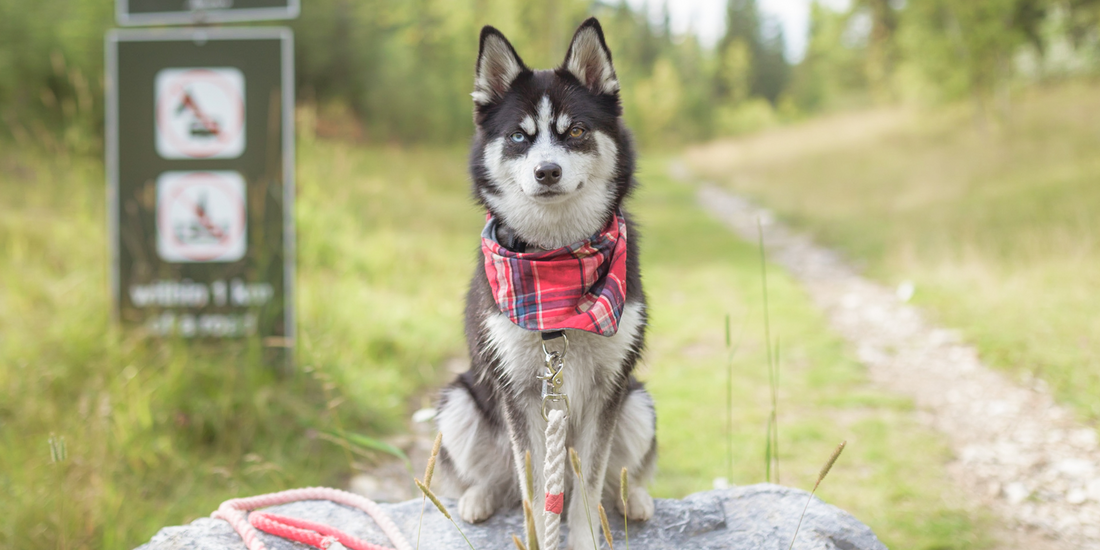There are more than 25,000 miles of hiking trails in the U.S. alone. That's why there's such a thing as trail etiquette. What even is that? Trail etiquette is a set of responsible and respectful hiking behaviors that allow us to be considerate to those we share the trail with - from people to animals to plants. We've already covered hiking safety, but these 10 trail etiquette guidelines for hiking with your dog will not only allow trail users to coexist, but also make the most of their excursion.
1. Only Go Where Dogs Are Allowed
Not all trails are pet-friendly, so make sure you take your pup to a dog-friendly one. Don't take your dog on a trail he or she is prohibited from - it's not fair to other hikers and could result in a violation ticket. Research ahead of time to avoid the disappointment of turning around right after arriving. Also make sure you obey all other trail rules once there.
2. Keep Your Dog On Leash
Your dog should always be leashed when hiking. This is especially important if he or she is reactive, does not recall (come when called), jumps on people or barks at strangers and other dogs.
Pro Tip: Avoid using a retractable leash on trails. They can get tangled around trees and bushes, make it more difficult to avoid approaching people or dogs and can break easily with all the shrubbery.
3. Clean Up After Your Dog
This is a pretty obvious one, but important to note nonetheless. Picking up your dog's waste not only means you're a responsible pet owner but also that you care about the trails, wildlife and other people.
4. Yield The Right-Of-Way
When encountering other hikers, yield the right-of-way by giving enough space for them to pass without being sniffed, licked or jumped on. Who has the right-of-way? In general, it is hikers going uphill for two reasons: it's more difficult for them to see oncoming hikers and more difficult, physically, to yield. That being said, uphill hikers may yield right-of-way to take a break or be polite, but that will vary based on the individual. In addition, individual hikers and hikers with dogs should yield to bikers, horse riders and groups because it's easier for them to do so.
Pro Tip: When yielding on a hillside, move uphill if the downhill side is too dangerous or difficult to stand on. Make sure you are visible to avoid startling other hikers and their animals.
5. Don't Let Your Dog Run Up To Others Without Permission
It's best not to let your dog approach other hikers on the trail. Your pup may be friendly, but that's only one side of the story. Others may be afraid of or allergic to dogs. If they have a dog, he or she may be reactive or in the middle of training. Or they may just not want to be interrupted on their hike. These are just a few reasons why not to allow your dog to approach others without permission.
6. Don't Approach Other Dogs Without Permission
For the same reasons mentioned above, it's also not a good idea to approach another dog without permission. In addition, don't whistle at, speak to or make sounds at them. Though it may seem harmless, it can disrupt and detract from the hiking experience. And always listen, accept and respect when others deny permission to approach or say their dogs are not friendly.
7. Abide By The "Leave No Trace" Rule
The "Leave No Trace" rule is about minimizing our impact on the great outdoors so we can protect and preserve the Earth. One practice is properly disposing of waste to avoid pollution and disease. Another is leaving areas as you found them and items where you found them. Yet another is not disturbing wildlife and plants.
Pro Tip: Do not roll rocks off cliffs. Not only does this mean you've moved something from where you found it, but it's also a safety hazards for people and animals below.
8. Stay On The Paved Trail
There's a paved trail for a reason and it's important to stay on it. For starters, it's safer to stick to the pathway. Secondly, it falls under the "Leave No Trace" rule by minimizing the impact you make on your surroundings. If your destination is off-trail, get there as directly as possible. But try to only wander off if absolutely necessary.
9. Be Aware Of Your Surroundings And Stay Alert
Because trails are for everyone and anyone, it's important to pay attention on your hike. Frequently scan for hikers, bikers and horse riders. Move out of the way when necessary and be careful around blind turns. Do your best to listen for the sounds of people, bike tires or horse hooves to avoid mishaps.
10. Prevent Disease
Make sure your dog is up-to-date on vaccines, flea and tick prevention and heartworm medication before hiking. This helps prevent the spread of disease as it avoids putting other hikers, their pups and wild animals at risk.

